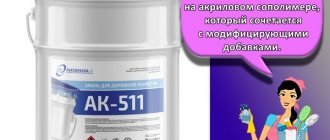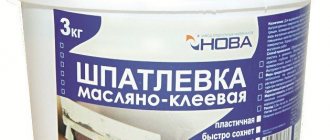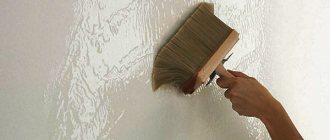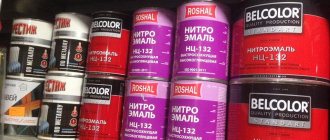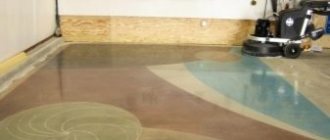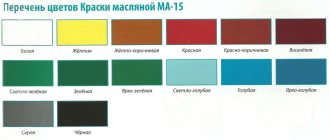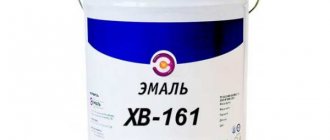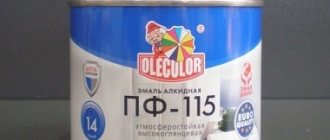Metal surfaces and products can lose their performance properties under the influence of various negative factors. To extend their durability, special materials are used that protect against corrosion, increase wear resistance, and increase hardness. One of them is the VL 02 primer. It coats metals for a short period of storage before subsequent processing or is used as an alternative to phosphating and oxidation.
Composition and technical characteristics of soil VL-02
The basis of the primer is a semi-finished product, which is mixed with an acid diluent. The first component contains:
- pigments;
- filler in a solution of polyvinyl resin;
- volatile organic solvents.
This material belongs to the group of phosphating primers, which create an anti-corrosion layer on the surface of metals of various types (iron, titanium, aluminum and others) and increase the adhesion of the paintwork.
To improve these characteristics, it is recommended to add aluminum powder to the initial mixture in an amount of 5-7% of the volume.
The characteristic features of the VL-02 primer include the following:
- creates a waterproof layer;
- protects the surface from the effects of petroleum products and mineral oils;
- neutralizes acids and salt solutions;
- prevents negative consequences when exposed to electricity.
VL-02 soil has the following technical characteristics:
| Film appearance | Homogeneous with a matte or glossy sheen |
| Conditional viscosity | 20-35 |
| Volatile content | 20-22 |
| Grinding degree | 30 micrometers |
| Drying time | 15 minutes |
| Flexural elasticity | 1 millimeter |
| Impact strength | 50 |
Due to the high concentration of volatile substances and the presence of a solvent in the composition, this soil is classified as a fire hazardous material. At the same time, thanks to the specified components and properties of the composition, the mixture can be used when working in industrial enterprises and at home in any climate zone.
Expert opinion
Zakharova Irina Yurievna
Cleaning professional with 15 years of experience. Our best expert.
Ask a Question
After drying, the soil forms a greenish-yellow film. However, the color of the coating may vary, since this parameter is not standardized.
PACKAGING, LABELING, TRANSPORTATION AND STORAGE
4.1. Packaging, labeling, transportation and storage of the primer base - in accordance with GOST 9980.3 - GOST 9980.5.
4.2. The base is packaged in steel flasks with an internal polyethylene coating or galvanized steel flasks in accordance with GOST 5799.
It is allowed, by agreement with the consumer, to pack the primer base in steel flasks in accordance with GOST 5799.
The acid diluent is packaged in glass bottles in wooden crates in accordance with GOST 18573 with a seal.
4.1, 4.2. (Changed edition, Amendment No. 2).
4.3. The primer base and acid diluent are stored and transported at temperatures from minus 10 °C to plus 30 °C.
It is allowed to store and transport the primer base and acid diluent at minus 30 °C, and the duration of storage and transportation should not exceed one month.
4.4. Marking of transport containers - in accordance with GOST 14192 with the application of handling signs - “Keep away from heat”, “Sealed packaging”, danger signs - in accordance with GOST 19433 (class 3, subclass 3.3, classification code 3313).
Glass bottles are additionally marked with the handling mark “Fragile. Carefully".
(Changed edition, Amendment No. 2).
Purpose and scope of application
VL-02 primer is intended to create a protective layer on the surface of the following metals:
- black;
- corrosion-resistant;
- galvanized and cadmium-plated steel;
- aluminum;
- copper;
- magnesium and titanium alloy.
See also
Is it necessary to prime wallpaper before painting, choice of material and main mistakes
The material is used as a base for various paints and putties applied to metal surfaces.
This mixture is applied to protect the car body. The material is also used in shipbuilding and other industries.
Pros and cons of the material
The advantages of this soil include the following:
- long service life;
- the ability to create a layer that protects against the effects of various aggressive substances, including salts and petroleum products;
- forms a moisture-proof layer;
- short hardening period;
- low consumption;
- suitable for use as a base for various paints and varnishes;
- the treated surface can be cut and welded.
Among the disadvantages of the primer are the following:
- high concentration of volatile and hazardous substances for the body;
- fire hazard;
- low coefficient of elasticity.
When working with primer, it is necessary to ensure constant ventilation of the room. Moreover, the material dries in 15-30 minutes even at room temperature, which speeds up the finishing of metal structures.
Types of soil VL-02
Many primer compositions differ from each other in the type of components that give the material additional properties. However, the VL-02 brand mixture always contains the same substances, regardless of the form of release and other conditions.
By composition, release form and properties
This primer composition is produced in a special container that does not let air inside. This mixture is divided into 2 types; VL-02 and VL-023. The difference between these compositions comes down to the fact that the first forms a moisture-proof layer that lasts no more than 6 months, the second - up to three years. In terms of technical characteristics and other criteria, both materials do not differ from each other.
By color variety
After drying, this primer forms a film with a matte or glossy sheen of a greenish-yellow hue. In this case, the color of the film can vary within a fairly wide range. This feature is explained by the fact that the shade of the primer is not standardized. And the saturation of the tone is determined depending on the number of layers applied.
Painting aluminum over old coatings
Is it necessary to pre-strip the old paint before applying the new one?
Not necessary - subject to two conditions:
- The old coating does not peel off.
- It is the same type as the new paint. Alkyd enamel can be safely painted over alkyd, XB-16 - over XB-16 and XB-124, and so on.
In all other cases, the paint is removed with organic removers.
Removal technology must take into account the limited mechanical strength of aluminum:
- After applying the remover, the aluminum is covered with polyethylene for 20-30 minutes. It is easier to wrap a small part in a rag soaked in detergent.
- The softened paint is removed from the surface with a wooden or plastic scraper.
Washing will help quickly remove the old coating.
Techniques for using soil
Due to the fact that VL-02 primer is a two-component composition that is supplied complete, the material must be thoroughly mixed before application. Also, to create a protective layer that can withstand the effects of these factors, you must follow the rules for processing metal surfaces.
See also
Technical characteristics and composition of enamel KO-8101, application rules
Calculation of material consumption
Soil consumption is determined depending on:
- tasks that the selected composition must solve;
- conditions of use (air temperature, humidity level, etc.);
- quality of surface preparation;
- the dyeing method used;
- configurations of processed metal structures and other factors.
On average, processing a square meter of metal surface in one layer requires 120-160 grams of the mixture.
Required Tools
The type of tools used when priming metal surfaces is determined by the work conditions. To apply the material the following are used:
- brush with a wide base;
- roller;
- spray.
You also need a container for mixing the solvent and the original composition. In addition, metal surfaces may require other tools or materials to prepare the structure for primer and paint.
RFG solvent is used to clean the brush or roller from mixture residues. Xylene can be used for these purposes.
Surface preparation
You can prime the surface after removing:
- traces of rust;
- fat;
- old paintwork.
To remove rust, use sandpaper or a grinder. You can also use specialized compounds that remove traces of corrosion.
Gasoline, alcohol and other compounds are used to degrease the surface. It is recommended to remove paint from metal structures using appropriate solvents. To increase the adhesion of VL-02 primer to the treated surface, it is recommended to treat the latter with fine sandpaper.
Application methods
Before applying the primer, the initial composition must be prepared following the following algorithm:
- Mix the soil with the acid diluent in a separate container in a ratio of 1:4.
- Continuously stir the resulting mixture for 10 minutes.
- Leave the mixture to steep for 30 minutes.
At the end of the specified period, a thinner can be added to the finished mixture to achieve the desired degree of viscosity of the primer composition. This setting is determined based on the type of tools used. If the primer is applied with a brush, the composition should be dense; if using a spray bottle - liquid (but not more than 20% of the primer weight).
To dilute the finished mixture, it is allowed to use:
- solvents 648 and R-6;
- xylene;
- toluene.
These solvents must not be mixed. Because of this, the properties of the primer will change.
To improve the characteristics of the material, you can also add aluminum powder to the finished mixture. The primer is applied in the same way as paint. When treating the surface, do not allow empty areas to remain.
See also
Composition of water-based paints and top 6 varieties, application rules
The prepared mixture can be stored for 4-24 hours, depending on the room temperature. After the specified period, the material must be disposed of. Applying VL-02 primer is allowed at temperatures from -10 to +30 degrees. The surface is treated with this mixture in 1 or 2 layers.
How long does it take for VL-02 primer to dry?
At a temperature of +20 degrees, this brand of soil dries completely within 15 minutes. However, the paint coating cannot be applied immediately. After the last layer has dried, it is recommended to keep the soil on the surface for half an hour. After this, the material can be painted.
VL-02 soil cannot be kept on metal for more than 14 days. After this period has expired, the surface should be re-treated with this material, since the previous layer loses its protective properties after 2 weeks.
TEST METHODS
3.1. Sampling - according to GOST 9980.2-86.
3.2. The mass fraction of non-volatile substances in the primer base is determined at (100 ± 2) °C for 1 hour. The mass of the sample is (2.0 ± 0.2) g.
3.1, 3.2 (Changed edition, Amendment No. 2).
3.3. Determination of base density
3.3.1. Device
The device (see drawing) is a duralumin glass with a lid. The lid, which fits tightly into the glass until it stops at the end, has a conical groove, which is designed to remove excess amounts of the test material through a central hole with a diameter of 2 mm. A mark is placed on the outside of the bottom of the glass indicating the glass’s own weight.
3.3.2. Carrying out the test
A device glass with a capacity of (100 ± 0.2) cm3 is filled with the primer base and closed with a lid. Excess primer is removed through the central hole in the lid. The glass together with the lid is weighed with an error of no more than 0.01 g.
3.3.3. Processing the results
The density of the primer base (ρ) in g/cm3 is calculated using the formula
where m
1—weight of the device without primer base, g;
m
2 - weight of the device with the primer base, g.
The arithmetic mean of two parallel determinations is taken as the measurement result, the permissible discrepancy between which should not exceed 0.1%.
3.4. Determining the appearance of an acid diluent
The appearance of the acid diluent is determined visually. The acid diluent is poured into a measuring cylinder made of colorless glass with a capacity of 100 ml (GOST 1770), examined in transmitted light and the absence of turbidity, delamination and suspended particles is noted.
1
- frame;
2
- cover
Drawing
3.5. Determination of the mass fraction of orthophosphoric acid in an acid diluent
3.5.1. Glassware, reagents and solutions
Rectified technical ethyl alcohol according to GOST 18300, premium grade;
burette with a capacity of 25 cm3 with a division value of 0.1 cm3;
cylinder 1.3-50 according to GOST 1770;
flask Kn-1-100-29/32 according to GOST 25336;
sodium hydroxide according to GOST 4328, concentration solution with
(NaOH) = 0.1 mol/dm3 (0.1 N);
phenolphthalein (indicator) alcohol solution with a mass fraction of phenolphthalein 1%;
distilled water according to GOST 6709.
3.5.2. Carrying out the test
0.5 - 1 g of acid diluent, weighed to the third decimal place, is placed in a conical flask, 25 ml of distilled water and two drops of phenolphthalein are added. The contents of the flask are thoroughly mixed and titrated with sodium hydroxide solution until a pale pink color appears, which does not disappear within 20 s.
3.5.3. Processing the results
Mass fraction of orthophosphoric acid ( X
) as a percentage is calculated using the formula
where V is the volume of sodium hydroxide solution with a concentration of exactly 0.1 mol/dm3, consumed for titration, cm3;
0.0049 is the mass of orthophosphoric acid corresponding to 1 cm3 of sodium hydroxide solution with a concentration of exactly 0.1 mol/dm3, g;
T
— weight of the acid diluent sample.
The arithmetic mean of two parallel determinations is taken as the measurement result, the permissible discrepancy between which should not exceed 0.05%.
3.5.1 — 3.5.3. (Changed edition, Amendment No. 2).
3.6. Preparing to test primers
3.6.1. Primers for testing are prepared by mixing the base with an acid diluent in glass, porcelain, enamel or other acid-resistant containers in the ratio specified in clause 1.6 of this standard.
When determining adhesion on plates made of aluminum-magnesium alloys, mixing the base with an acid diluent is carried out in the ratio specified in clause 1.6 of this standard.
After preparation, the primer is kept for 30 minutes and the relative viscosity, dilution percentage and stability are determined.
To determine other indicators, the primer is diluted with the RFG solvent to a viscosity of 16 - 20 s using a VZ-246 (VZ-4) viscometer, filtered through a sieve with mesh No. 008 k (GOST 6613) or three layers of gauze and applied with a paint sprayer in one layer on the prepared plates according to GOST 8832, section. 3.
The film thickness of a single-layer coating should be 8 - 10 microns for VL-02 brand primer and 15 - 18 microns for VL-023 brand primer. The film thickness is determined by magnetic and vortex thickness gauges, providing a basic error of ±5%, after the film has dried according to the regime of subparagraph 5 of the table. 5.
3.6.2. The appearance of the film, drying time, and the elasticity of the film when bending are determined on plates made of black hot-rolled sheet metal measuring 70x150 mm (20x150 mm when determining the elasticity of the film when bending), 0.25 - 0.28 mm thick.
The strength of the film upon impact is determined on plates made of steel grades 08kp and 08ps (GOST 16523) with a size of 70x150 mm and a thickness of 0.8 - 0.9 mm.
Adhesion is determined on plates made of steel grades 08kp and 08ps (GOST 16523) or on plates made of alloys grades D16 and AMg6 (GOST 21631) measuring 70×150 mm.
Before testing according to the indicators of subparagraphs 6, 7, 8 of table. 5 coatings after drying are kept at (20 ± 2) °C for 24 hours.
3.6.1, 3.6.2 (Changed edition, Amendment No. 2).
3.7. Determining the appearance of the film
The appearance of the film is determined visually in natural diffused light after drying at (20 ± 2) °C for 15 minutes.
3.8. Determination of primer stability
The stability of primers is determined by the change in viscosity after mixing the base with an acid diluent in the ratios specified in clause 1.6 of this standard, 6 hours after curing the primer. Tests are carried out in a tinplate jar in accordance with GOST 6128 or other acid-resistant containers with a tight-fitting lid.
The percentage change in viscosity (X1) is calculated using the formula
where η1 is the conditional viscosity of the primer, determined according to clause 3.6.1 and subclause 2 of table. 5, s;
η2 is the conditional viscosity of the primer, determined 6 hours after mixing the base with the acid diluent, s.
3.9. Determination of the percentage of dilution of primers with a solvent
50 - 100 g of primer prepared according to clause 3.6.1 are weighed to the first decimal place and diluted with the solvent specified in subclause 4 of the table. 5, up to a viscosity of 20 s using a viscometer type VZ-246 (or VZ-4).
The percentage dilution with solvent (X2) is calculated using the formula
where t
— primer mass, g;
m1
— mass of solvent used to dilute the primer, g.
3.8, 3.9. (Changed edition, Amendment No. 2).
Mistakes when applying primer
Errors when using a primer composition mainly come down to non-compliance with the rules for preparing the material. Often, when mixing, unsuitable solvents are used or the latter are added in higher concentrations, which leads to a deterioration in technical characteristics and a decrease in protective properties.
To avoid problems when processing metal structures, it is necessary to add a thinner in an amount not exceeding 20% of the soil volume. Otherwise, the mixture will turn out to be too liquid, which will increase material consumption. In such circumstances, you can treat the surface with sandpaper, thereby increasing the level of adhesion of the metal to the soil.
The second common mistake is failure to comply with the conditions for aging the composition. Before applying paint, you must wait at least half an hour. During this time, the primer will gain the specified strength characteristics necessary to protect the metal from external influences.


